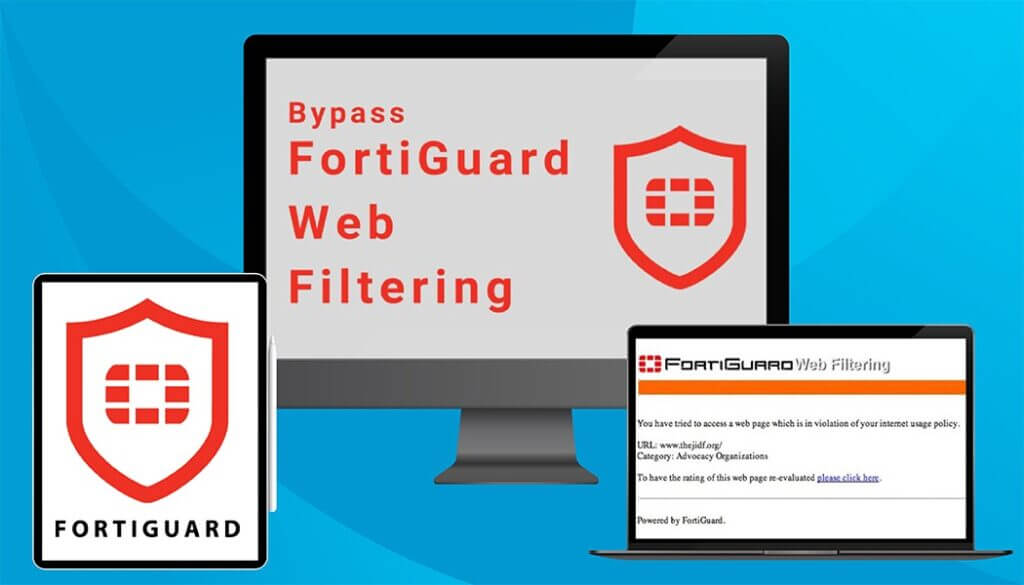Fortiguard is a popular firewall application used by schools and businesses to block certain websites. This is done in order to restrict content that is deemed harmful or irrelevant by the network administrator. However, Fortiguard can sometimes inadvertently block useful websites as well.
In this article, we’ll show you how Fortiguard works and how to bypass Fortiguard.
How Fortiguard Works
When installed, Fortiguard provides a blacklist that is controlled by the network administrator. This blacklist is used to filter out objectionable websites or applications in a manner similar to DNS filtering.
When attempting to access any website or application on a network with Fortiguard installed, Fortiguard will intercept the request and check it against the blacklist. If the website is on the blacklist, Fortiguard will deny you access.
Fortiguard is used by school and business networks for a variety of reasons. Objectionable or obscene content is typically banned. Social media sites are also often banned to prevent students or employees from being distracted while they are working.
Other reasons network administrators may use Fortiguard is as a security measure, banning websites that may contain malware. Some networks may also use Fortiguard to ban streaming sites in order to conserve bandwidth.
Bypassing Fortiguard: Know the Risks
Before you attempt to bypass Fortiguard on your school or business network, there are some things you should know.
Schools and businesses generally require users to agree to a Terms of Services Agreement, Acceptable Use Policy, or similar legal agreement as a precondition of using their network. If you had to agree to one of these policies in order to access the network, bypassing Fortiguard may be a violation of it.
Additionally, if you are detected bypassing Fortiguard, you may face consequences for doing so.
How to Bypass Fortiguard
Here are methods you can use to bypass Fortiguard.
1. Use Your Mobile Network
This is the easiest and risk-free way of getting past Fortiguard. Since Fortiguard can only function on the network that it’s installed on, simply using a different network, such as your mobile network, will allow you to ignore Fortiguard entirely. You also won’t be breaking any TOS agreements.
The main downside of using this method is that depending on your cell phone plan and online activity, using your own mobile data can get expensive.
2. Visit Mirror Sites
Many popular websites, such as Instagram and Twitter, have unofficial “mirror versions” that can be accessed through a Fortiguard blacklist. You may need to do some digging to find these mirror sites, but Google is a great place to start. You can also find links on Reddit and other social media sites.
Mirror sites can be used to bypass Fortiguard because Fortiguard can only block websites that are specifically blacklisted, and while network administrators will block popular sites, it is very rare that they will block mirror sites.
3. Use Proxy Sites
Proxy sites can be used to disguise your DNS requests from Fortiguard, allowing you to access blacklisted URLs. Sites such as Hide My Ass and ProxySite are free to use, and there are many more you can find via Google.
The downside of using proxy sites is that they have slow connection speeds and are often full of ads, but they can work in a pinch.
How to Use a VPN to Bypass Fortiguard
The most effective way to bypass Fortiguard, by far, is to use a VPN. VPNs encrypt all of your browsing traffic, preventing Fortiguard from identifying what websites you are seeing and allowing you to use the Internet without fear of running into the blacklist.
There are numerous VPNs out there, such as NordVPN, ExpressVPN, CyberGhost, and ProtonVPN that offer strong security features and fast performance.
Generally, installing and connecting to the VPN is all you need to bypass Fortiguard. Depending on your network administrator’s settings, you may need to try multiple servers before finding one that works.
However, some network administrators will use Fortiguard to block VPN use. If this happens to you, you’ll need to use a VPN with a “stealth” or “obfuscation” mode. This disguises your VPN so that Fortiguard doesn’t block its use, allowing you to browse in peace.
Additionally, if you are not able to download your VPN provider’s app to your computer due to Fortiguard’s settings, you may have to use your VPN via a browser extension instead. This will limit your VPN usage to that particular browser, but it will allow you to access blacklisted sites.
Another method to bypass Fortiguard installations that block VPN use is to use the Tor network. Tor is an anonymous communication network that functions similarly to a VPN. You can combine a Tor and VPN connection to bypass Fortiguard, albeit at the cost of performance.
When using a VPN on a Fortiguard-protected network, make sure to enable DNS leak protection. This will ensure that your device’s DNS requests are made within the VPS and cannot be detected by Fortiguard. Most VPNs will have DNS leak protection turned on by default.
Finally, when using a VPN to bypass Fortiguard, you should always ensure that the killswitch feature is enabled. VPN killswitches will automatically terminate your Internet connection if you’re disconnected from the VPN, preventing Fortiguard from noticing your browsing history.
Bypassing Fortiguard: The Bottom Line
As one of the most common firewall programs out there, Fortiguard can be frustrating for computer users. While its use is understandable for network administrators, Fortiguard can sometimes block important websites and needlessly obstruct users’ work.
By using these methods, you’ll be able to get past Fortiguard’s blacklist and enjoy the Internet the way you want to. If you opt to use a VPN, you’ll additionally be able to remain anonymous online.

